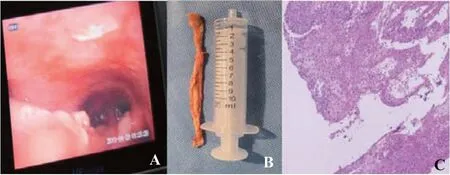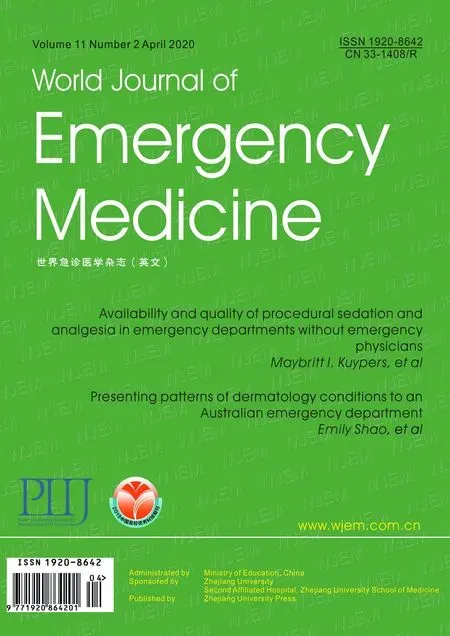Acute obstructive f brinous laryngotracheobronchitis induced by severe glyphosate surfactant intoxication:A case report
Feng-lu Yang, Xiao Lu
1 Hangzhou Emergency Center, Hangzhou 310010, China
2 Department of Emergency Medicine, the Second Aff iliated Hospital of Zhejiang University School of Medicine, Hangzhou 310009, China
Dear editor,
Glyphosate is a nonselective herbicide commonly used in agriculture worldwide. Glyphosate targets the shikimate metabolic pathway, which is found in plants but not in animals. Therefore, it is considered to be of low toxicity to humans, supported by the finding of high concentrations of oral and dermal LD50(>5,000 mg/kg body weight) of glyphosate in experimental animals.[1,2]Ingesting commercial formulations of glyphosate surfactant herbicide (GlySH), however,has been reported to be associated with various toxic effects, including gastrointestinal injury, laryngeal injury,impaired renal function, metabolic acidosis, arrhythmias,pulmonary toxicity, shock, and even death.[3]Recently,glyphosate surfactant has been used with increasing frequency in suicide attempts, and clinical toxicologists have encountered fatal cases of glyphosate surfactant poisoning.[4]Mortality from ingesting glyphosate surfactant varies from 0% to 29.3%, depending on patients’ characteristics such as age and intent of exposure.[5–7]Acute f ibrinous laryngotracheobronchitis is often seen in infants and children, but it is rare in adults.Here we present a case with acute obstructive fibrinous laryngotracheobronchitis induced by severe glyphosatesurfactant intoxication.
CASE
A 52-year-old woman ingested 250 mL of glyphosate surfactant in a suicide attempt and was admitted to the emergency department (ED). CT scans of the chest showed slight aspiration pneumonitis in the ileus of the intestine. The patient had no respiratory failure or shock after treatment, which inculded the gastric lavage and hemodiafiltration in the ED. She was then transferred to the intensive care unit (ICU) for further treatment. However, she experienced sudden hoarseness and shortness of breath in the middle of the night after her second day’s treatment in the ICU. She had typical symptoms of upper-airway obstruction,and the peripheral oxygen saturation (SpO2) decreased to 70%–75%. The patient was immediately intubated and mechanically ventilated, but the SpO2remained low (85%–90%) as the FiO2was 100%, and the peak inspiratory pressure of mechanical ventilation exceeded 40 cmH2O, indicating possible airway obstruction. We examined her with the bronchoscope, and found large numbers of hyperplasias in the pseudomembrane blocked the principal bronchus (Figure 1A). We tried to remove the hyperplasia from the bronchus but failed, because it was too large and tightly attached. The patient underwent emergency tracheotomy, and the main pseudomembrane was taken out from the tracheostoma (Figure 1B). SpO2increased to normal levels after these treatments, and we removed more pseudo-membranes from the bronchus on the second day. The pathological report of this hyperplasia showed the inflammatory lesion of tissues(Figure 1C). Psychoanalyst was called for evaluating the mental problem of the patient and helping her with some psychotherapies. The patient left the hospital after 2 weeks, with good prognosis.

Figure 1. Results of bronchoscope and pathological report. A: The bronchus blocked by pseudomembrane; B: the pseudomembrane taken out under the bronchoscope; C: the pathological report of this hyperplasia showing the inf lammatory lesion of tissues.
DISCUSSION
Glyphosate inhibits plant growth by interfering with the 5-enolpyruvylshikimate-3-phosphate synthase(EPSP), which is required for the production of aromatic amino acids. The precise mechanism underlying GlySH inhibition is unclear. Damage to cellular components,including the mitochondria, cell membrane, and deoxyribonucleic acid (DNA), and to protein synthetic machinery has been reported. However, evidence shows that the surfactant coformulant, not the glyphosate herbicide, is responsible for most of these effects. The surfactants interact with mitochondrial membranes,interfering with oxidative phosphorylation and cellular energy production.[8]Toxicity symptoms differ from mild gastrointestinal discomfort to severe renal,cardiovascular, and respiratory failure. Although GlySH is less toxic to humans than to plants, poisoning can be fatal.[9–11]Acute fibrinous laryngotracheobronchitis is common in infants and children but very rare in adults. This case showed acute obstructive fibrinous laryngotracheobronchitis induced by glyphosate surfactant, which has never been reported before; the f ibrinous laryngotracheobronchitis may have been caused by aspiration pneumonia or glyphosate surfactant, and inf lammatory lesions might have caused the cells of the alveolar epithelium to transfer to the pseudo-membranes.The key treatment for this patient was keeping the airway unobstructed, relieving obstruction through the bronchoscope or tracheotomy. In future cases, we should also pay close attention to the pseudomembranes after initial treatment.
CONCLUSION
The toxicokinetics of glyphosate surfactant is complicated. Respiratory failure, metabolic acidosis,tachycardia, elevated creatinine, and hyperkalemia are poor prognostic factors if present. The reason for the laryngotracheobronchitis in this patient was unclear, but clinicians must be careful when treating patients with severe glyphosate-surfactant intoxication, even if they do not initially have respiratory failure.
Funding:None.
Ethical approval:Not needed.
Conf icts of interest:There is no conf lict of interest in this study.
Contributors:FY proposed the study, and wrote the f irst draft. All authors read and approved the f inal version.
 World journal of emergency medicine2020年2期
World journal of emergency medicine2020年2期
- World journal of emergency medicine的其它文章
- Availability and quality of procedural sedation and analgesia in emergency departments without emergency physicians: A national survey in the Netherlands
- Presenting patterns of dermatology conditions to an Australian emergency department
- Effect of neutrophil CD64 for diagnosing sepsis in emergency department
- Post-dilatation improves stent apposition in patients with ST-segment elevation myocardial infarction receiving primary percutaneous intervention: A multicenter, randomized controlled trial using optical coherence tomography
- Predictive role of interleukin-6 and CAT score in mechanical ventilation in patients with chronic obstructive pulmonary disease at the acute exacerbation stage in the emergency department
- Changes in peak inspiratory f ow rate and peak airway pressure with endotracheal tube size during chest compression
